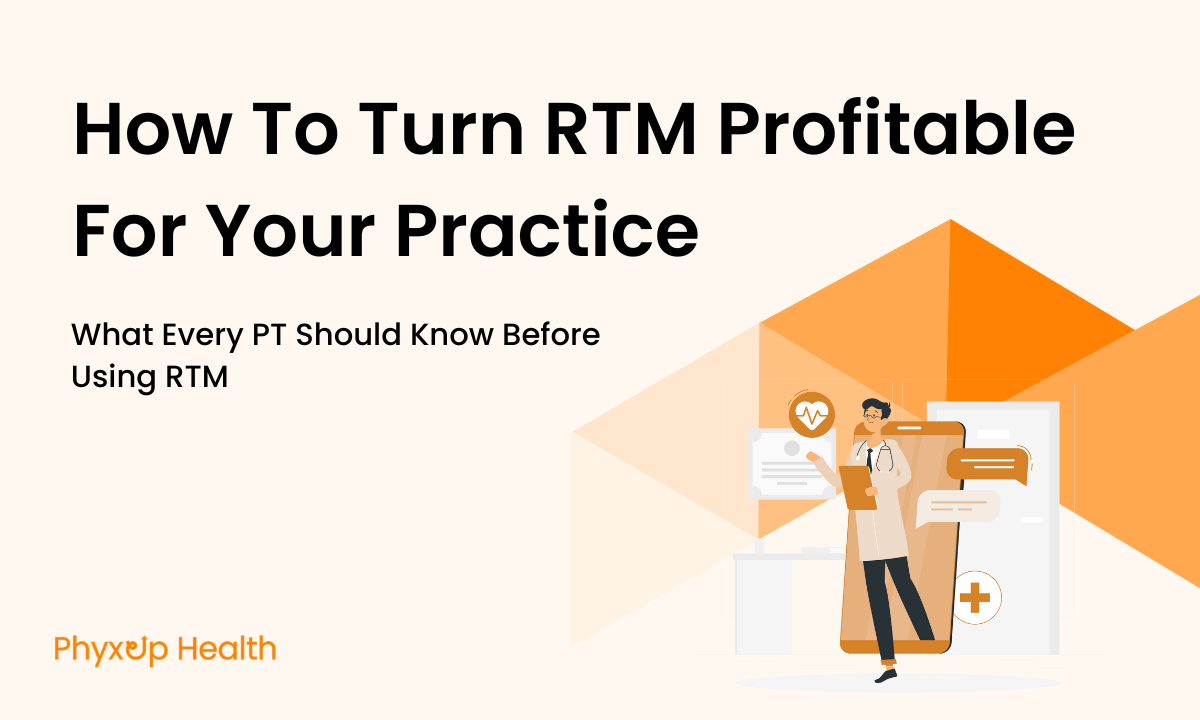How To Turn RTM Profitable For Your Practice

At first glance, Remote Therapeutic Monitoring (RTM) can feel like just another tech trend in the physical therapy world, promising big results but adding extra work to your clinic. The onboarding process may seem overwhelming, and without the right approach, RTM can feel like a platform that complicates day-to-day operations without delivering noticeable benefits in patient satisfaction or revenue.
The good news? When implemented effectively, RTM can transform into a powerful tool for your practice. It can become a reliable source of revenue and boost patient engagement. In this article, we’ll show you how to turn RTM from a source of concern into a cornerstone of your practice.
RTM That Works For You, Not You Work For
When practices consider adding an RTM platform, the biggest question isn’t “Does it sound good?”, it’s “Will this be worth the time?” Time is the currency of every clinic, and the wrong platform can drain more of it than it gives back.
We’ve seen it happen: clinics adopt RTM but end up with more headaches than help. Instead of streamlining operations, the platform:
- Adds extra administrative work, forcing staff to manually enter billable units
- Slows down patient onboarding, making adoption a barrier rather than a bridge
- Creates cumbersome workflows, where therapists spend more time digging through data than treating patients
- Frustrates patients with poor usability, leading to lower HEP adherence and satisfaction
The right RTM solution should be invisible in the background, automating the busywork, supporting patient engagement, and opening doors to reliable revenue growth.
Intuitive Onboarding Process For Clinics and Patients
Bringing an RTM platform into your practice doesn’t have to mean reinventing the way you work. The key is a seamless onboarding process that fits naturally into your existing workflow.
At PhyxUp Health, we’ve simplified onboarding for both therapists and patients into a few straightforward steps, so you can start seeing the benefits of RTM without the growing pains.
Step 1. Initial Visit
The process starts in the clinic. The therapist provides treatment, sets recovery goals, and introduces the patient to a personalized home exercise program (HEP).
Step 2. HEP Assignment Through App
Between visits, patients complete their assigned HEP through a mobile platform. Each video is customized to their specific condition, body part, and recovery stage.
Step 3. Real-Time Data Collection
As patients complete their exercises, RTM technology tracks key information in real-time such as HEP adherence, pain levels, daily activity, heart rate, and even sleep patterns.
Step 4. Data Review and Adjustment
Therapists can review the collected data directly on their RTM dashboard. The platform helps identify progress and challenges, supporting therapists in making informed updates to treatment plans and exercise prescriptions.
Step 5. Automatic Insurance Billing
At the end of each month, the RTM platform organizes all patient activity and therapist input into ready-to-use documentation. SOAP notes and CPT code-based billing reports are automatically generated, streamlining the reimbursement process.
Want to dig deeper? Check out this beginner's guide on RTM, breaking down everything from how it works day-to-day to details, billing requirements, and what it means for your practice.
Utilizing RTM's Automated Features
One of the biggest advantages of RTM is its ability to take administrative work off your plate. Yet many clinics aren’t fully leveraging these tools. By automating repetitive tasks, RTM platforms free up valuable time, so you can invest more into patient care, higher patient volume, or even just reducing burnout for your staff.
Here are a few ways to use RTM to automate and streamline your clinic workflow:
📈 Real-Time Patient Data Analysis
RTM platforms don’t just collect data, they make sense of it. Information like HEP adherence, reported pain levels, and data from health trackers (e.g., Apple Health) is automatically analyzed to spot trends in patient progress and overall health, giving you actionable insights without the hours of manual review.
💰 Integrated Automatic Billing
Forget chasing paperwork at the end of the month. RTM systems compile patient activity and therapist input into clean, ready-to-use billing reports. No more scrambling to organize spreadsheets or double-check CPT codes, the platform handles it for you.
📝 Automatic Documentation
SOAP notes and other billing-required documents are generated automatically based on patient data collected in the system. These records are not only CPT-compliant but also provide therapists with easy reference points for adjusting treatment plans.
👨⚕️ Adjustments in Treatment Plan (Full-Service)
PhyxUp Health goes a step further with a fully managed RTM service. Our in-house licensed therapists conduct the patient check-ins and remote monitoring on your behalf, so your team doesn’t need to spend time on the “remote” portion of RTM. You still benefit from the reimbursements, while RTM handles the administrative and clinical follow-up remotely.
RTM Supports, Not Replaces, Human Care
Even with all its automated features, it’s important to remember that patient care remains human-driven. RTM is a tool designed to assist physical therapists, helping them deliver better outcomes, but it doesn’t replace the therapist’s judgment or expertise.
The final decisions about treatment always rest with the therapist. RTM’s role is to handle administrative tasks, streamline workflows, and free up time, so therapists can focus on what they do best: treating patients.
Improve Revenue Generation With RTM
Asides from saving valuable time for your practice, another important way RTM can help your clinic is through becoming a sustainable source of revenue generation through CMS-approved billable CPT codes. Here's a break down of how:
Initial Setup and Patient Education: CPT Code 98975
This one-time code covers the initial setup of the RTM device and patient education on its use. It ensures patients are well-prepared to engage with the monitoring system, laying the foundation for effective remote care.
RTM Device/App Supply: CPT Code 98977
This code is billed monthly and covers the supply of a device that monitors musculoskeletal system status, including therapy adherence and response. It requires at least 16 days of data collection within a 30-day period.
First 20 Minutes of Treatment: CPT Code 98980
Billed monthly, this code reimburses for the first 20 minutes spent on treatment management activities such as reviewing patient data, adjusting treatment plans, and conducting interactive communications with the patient or caregiver. At least one interactive communication is required.
Additional 20 Minutes of Treatment Management: CPT Code 98981
This add-on code is used for each additional 20 minutes of treatment management beyond the initial 20 minutes covered by CPT 98980. It allows for extended engagement and adjustment of the treatment plan as needed.
📊 Real-Life Example: How RTM Generates Revenue
Meet Antonio, a new patient recovering from an ankle injury at one of our client clinics. His PT clinic implements RTM to support his recovery and monitor progress remotely. Here’s how it unfolds over his first month, including potential reimbursement:
Week 1: Initial Setup and Education
Antonio, a 32-year-old former runner, comes in after an ankle sprain. His therapist sets up RTM, walks him through the app, and assigns a starter HEP. He learns how to log exercises, track pain, and sync step data.
💰 Billable Unit/Amount: CPT 98975 / $19
Weeks 2: Device Monitoring & Communication
Antonio follows his HEP at home while RTM tracks adherence, pain, and steps. When he misses a few logs, his therapist sends a quick reminder through in-app messaging to keep him consistent.
💰 Billable Unit/Amount: CPT 98977 / $55
Week 3–4: Data Insights and Adjustments
RTM data shows Antonio is overdoing it—too many steps for his ankle recovery. The therapist adjusts his program, adding rest and low-impact exercises, and reinforces the changes via messaging and a short video call.
💰 Billable Unit/Amount: CPT 98980 / $50
Week 4: Treatment Management
At month’s end, the therapist reviews progress, fine-tunes the HEP, and checks in with Antonio via messaging and a video call. Total time: 20 minutes.
💰 Billable Unit/Amount: CPT 98981 / $40
Total Revenue For The Month:
$19 (98975) + $55 (98977) + $50 (98980) + $40 (98981) = $164
At the end of the month, as a result of RTM, Antonio has managed to stay engaged, avoid setbacks, and recover safely. For the clinic, this first month generated $164 in reimbursable revenue with minimal added administrative work.
Why Choose PhyxUp to Unlock RTM Profitability?
PhyxUp Health takes the guesswork out of RTM, transforming it from a time-consuming add-on into a sustainable revenue driver for your clinic.
- 💡 Smarter Workflows – Automations cut down on admin time so your team can focus on patients, not paperwork
- 💻 Seamless EMR/EHR integration – Fits directly into your clinic workflow without adding complexity
- 👷♂️ HIPAA-compliant security – Protects patient data while supporting remote monitoring
- 💸 Built-In Billing – CMS-approved RTM codes are automatically tracked and billed, ensuring your clinic captures every dollar of reimbursable care
- 📊 Transparent Results – Real-time dashboards show exactly how RTM is impacting both patient outcomes and your bottom line
- 🙌 Full-Service Support – From onboarding patients to managing remote check-ins, PhyxUp offers flexible options that scale with your clinic’s needs
With PhyxUp, RTM isn’t just another tech fad, it’s a proven way to help clinics grow revenue, increase efficiency, and strengthen patient relationships.
If your practice is ready to turn RTM into a profitable, sustainable part of your care model, PhyxUp Health is the partner to make it happen.
